Tài liệu Phát triển nông nghiệp ven đô bền vững ở Việt Nam
1.1 Cơ sở lý luận về phát triển nông nghiệp ven đô bền vững
1.1.1 Một số khái niệm liên quan
Khái niệm về Phát triển bền vững
Phát triển bền vững là một trong những tính chất quan trọng trong mọi hoạt động
của hệ thống với chính sách hoạch định cố kết trong nội bộ, không được phát sinh
những xung đột cơ cấu do mang vào đó những tiêu chí mâu thuẫn về thực hiện. Sự tác
động qua lại giữa hệ kinh tế xã hội và hệ sinh thái thường diễn ra trong tổng thể của
những vấn đề toàn cục. Sự phát triển thưòng mang tính gắn kết hữu cơ giữa tăng trưởng
vật chất với giới hạn của hệ sinh thái (chất lượng môi trường và tài nguyên thiên nhiên)
trên các lãnh thổ.
Năm 2002 Hội nghi Thượng đỉnh thế giới về Phát triển bền vững tại
Johannesburg (Cộng hoà Nam Phi) cũng đã thống nhất nội dung do Viện Quốc tế về
Môi trường và Phát triển (I.I.E&D) tổng hợp và đề xuất dựa theo tính chất cân bằng
động của hệ thống lớn gồm ba hệ thống các mục tiêu: phát triển kinh tế, phát triển xã
hội và bảo vệ môi trường.
Có thể nói phát triển bền vững vùng ven đô của các thành phố là phát triển bền
vững là sự hiển thị của phát triển bền vững lãnh thổ. Phát triển bền vững theo sơ đồ của
Munasingle đưa ra 3 đỉnh của 1 tam giác là: “Kinh tế lãnh thổ”, “xã hội hài hòa”,
“Môi trường bền vững”
Phát triển bền vững là yêu cầu của quy luật khách quan trong nghiên cứu phát
triển kinh tế xã hội quốc gia nói chung, mà nội dung quyết định lại là tổ chức lãnh thổ
sao cho bền vững bởi vì “Vùng” là những tế bào sinh tồn của lãnh thổ.
Khái niệm Phát triển nông nghiệp bền vững
Đối với các nước đang phát triển, kinh tế phụ thuộc nhiều vào nông nghiệp thì
phát triển nông nghiệp bền vững là một trong những nội dung chủ chốt của phát triển
bền vững. Khái niệm phát triển nông nghiệp bền vững không thể tách rời phát triển khu
vực nông thôn bền vững.
Nhìn lại quá trình hiện đại hoá nông nghiệp thế giới trong thế kỷ XX, có thể thấy
nổi lên ba đặc điểm cơ bản: (1) hiện đại hoá công cụ sản xuất nông nghiệp, có nghĩa là
sử dụng một cách rộng rãi thiết bị cơ giới để thay thế sức người, gia súc và công cụsản5
xuất truyền thống; (2) hiện đại hoá kỹ thuật sản xuất, có nghĩa là ứng dụng rộng rãi khoa
học kỹ thuật vào sản xuất nông nghiệp; và (3) hiện đại hoá phương thức sản xuất, có
nghĩa là chuyển nông nghiệp từ sản xuất cá thể tự cung tự cấp sang sản xuất xã hội quy
mô lớn, có tính chuyên nghiệp hoá cao. Những đặc điểm này đã chi phối nhận thức của
con người vềphát triển nông nghiệp trong phần lớn thời gian của thếkỷ XX. Tuy nhiên,
kể từ cuối những năm 1980, cùng với sự hình thành và tiến triển nhanh chóng của nhiều
xu thế mới trên thế giới, nhận thức của con người về nông nghiệp, nông thôn và nông
dân đã có những thay đổi.
Khái niệm “Phát triển nông nghiệp và nông thôn bền vững” lần đầu tiên được
đưa ra ở Hội nghị về Nông nghiệp và Môi trường của Tổ chức Nông Lương thế giới
(FAO) tại Hertogenbosch năm 1991. Khái niệm này đã được khẳng định tại Hội nghị
Thượng đỉnh Trái đất tại Rio de Janeiro năm 1992 trong Chương 14 của Chương trình
Nghị sự 21, và tiếp tục được tái khẳng định tại Hội nghị Thượng đỉnh về Phát triển bền
vững tại Johannesburg năm 2002.
Phát triển nông nghiệp và nông thôn bền vững là một quá trình đa chiều, bao
gồm: (1) tính bền vững của chuỗi lương thực (từ người sản xuất đến người tiêu thụ, liên
quan trực tiếp đến cung cấp đầu vào, chế biến và thị trường); (2) tính bền vững trong sử
dụng tài nguyên đất và nước về không gian và thời gian; và (3) khả năng tương tác
thương mại trong tiến trình phát triển nông nghiệp và nông thôn để đảm bảo cuộc sống
đủ, an ninh lương thực trong vùng và giữa các vùng.
Quan niệm về phát triển nông nghiệp và nông thôn bền vững đã có ảnh hưởng
đến các cách thực hành trong nông nghiệp. Các cách thực hành này phải đảm bảo tính
chất bền vững, có nghĩa là phải đáp ứng đồng thời ba mục tiêu: (1) bền vững về sinh
thái; (2) lợi ích về kinh tế; và (3) lợi ích xã hội đối với nông dân và cộng đồng. Trong số
ba mục tiêu nêu trên, mục tiêu bền vững vềsinh thái được coi là rất mới. Để đạt được
mục tiêu này, các chủ thể canh tác nông nghiệp phải đồng thời thực hiện quản lý đất bền
vững, quản lý sâu bệnh bền vững và bảo vệ đa dạng sinh học.
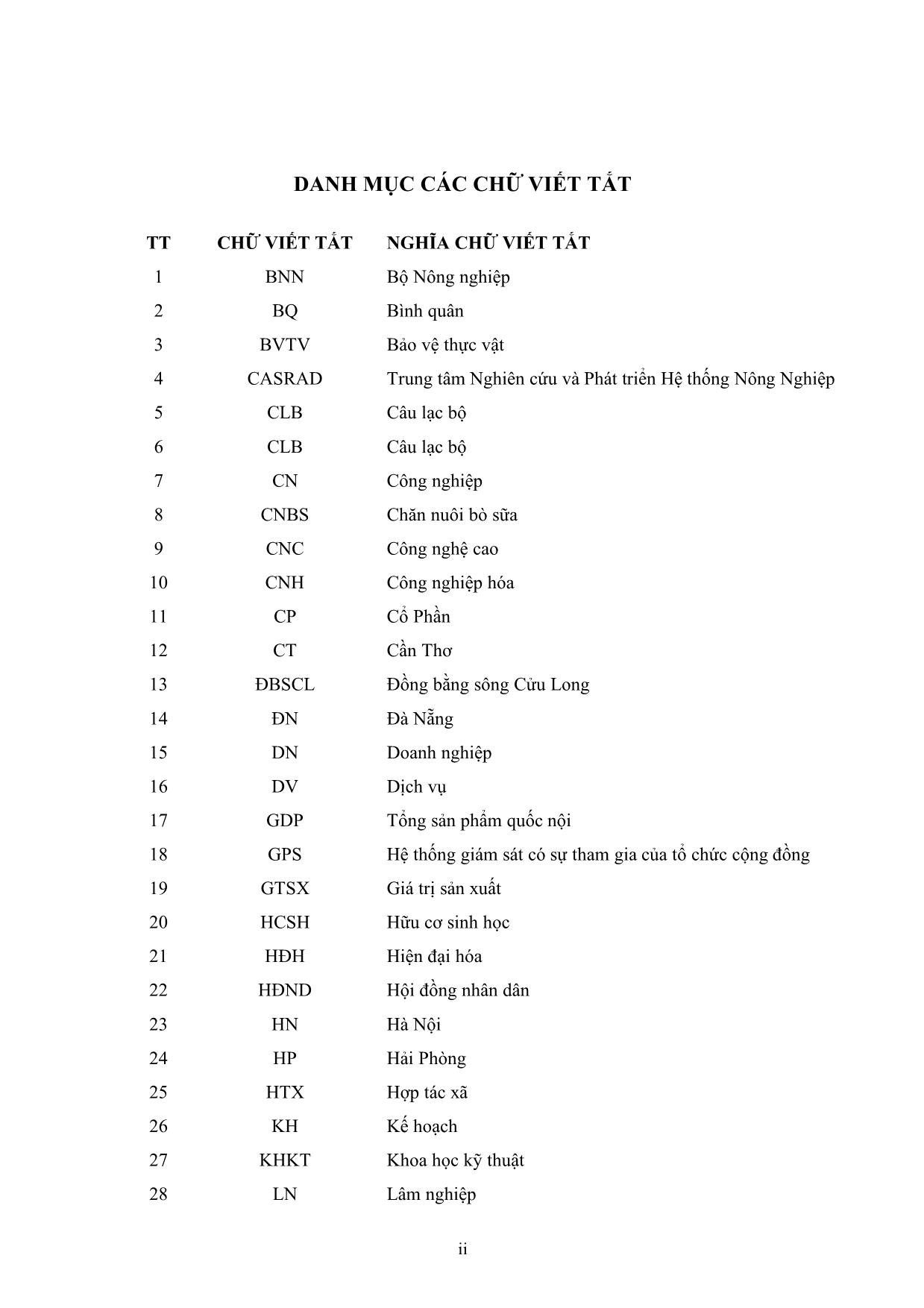
Trang 1

Trang 2
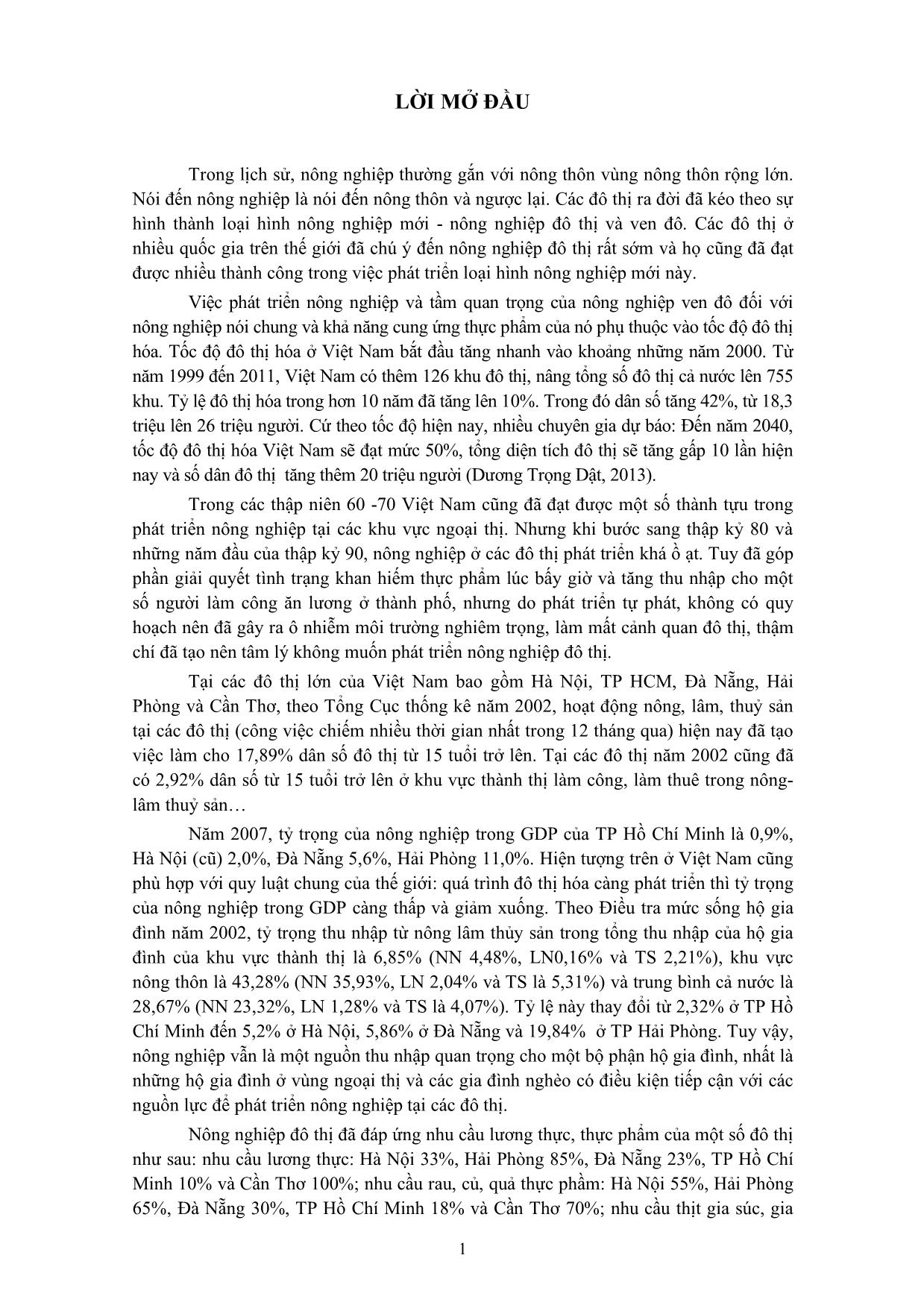
Trang 3

Trang 4
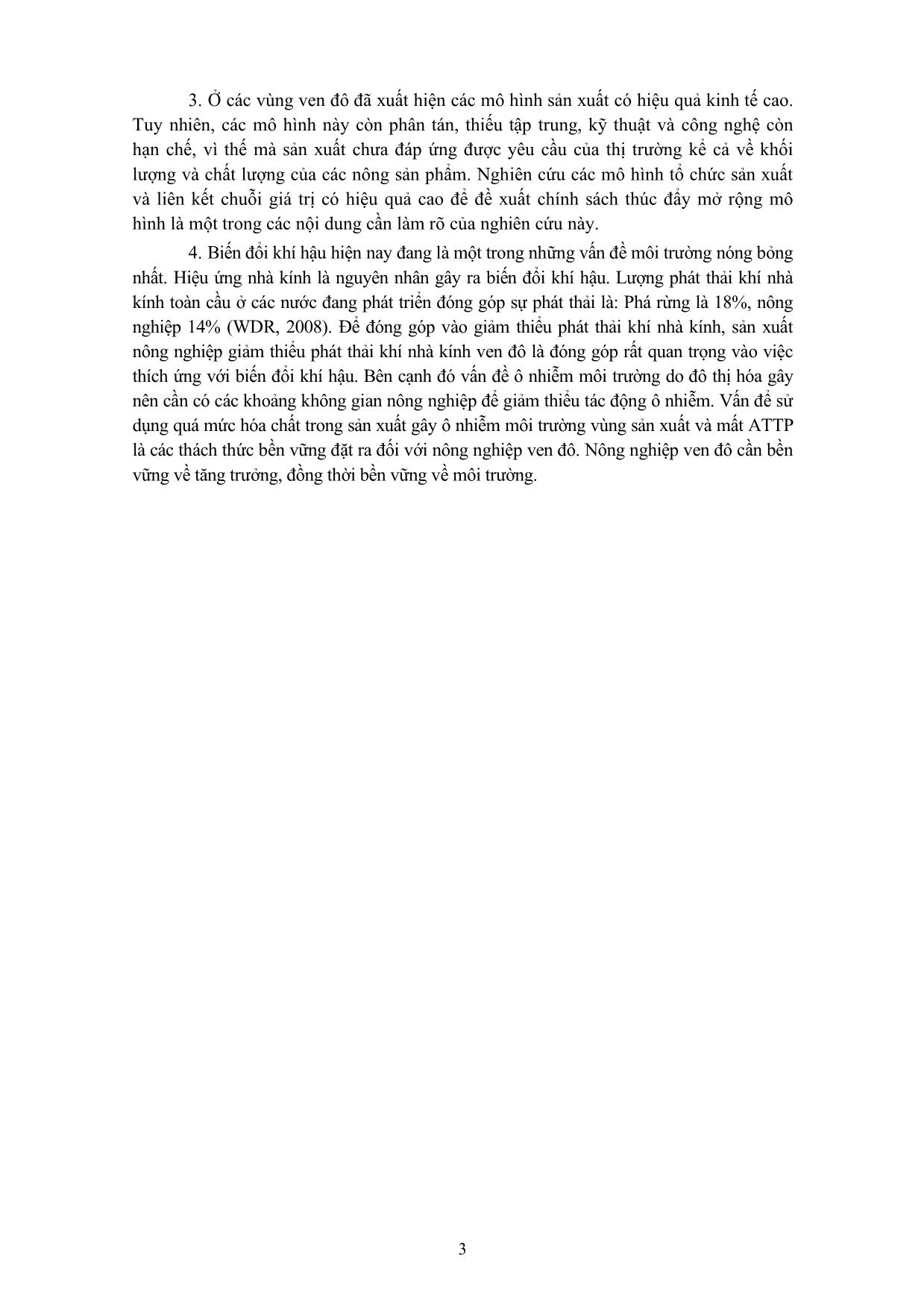
Trang 5
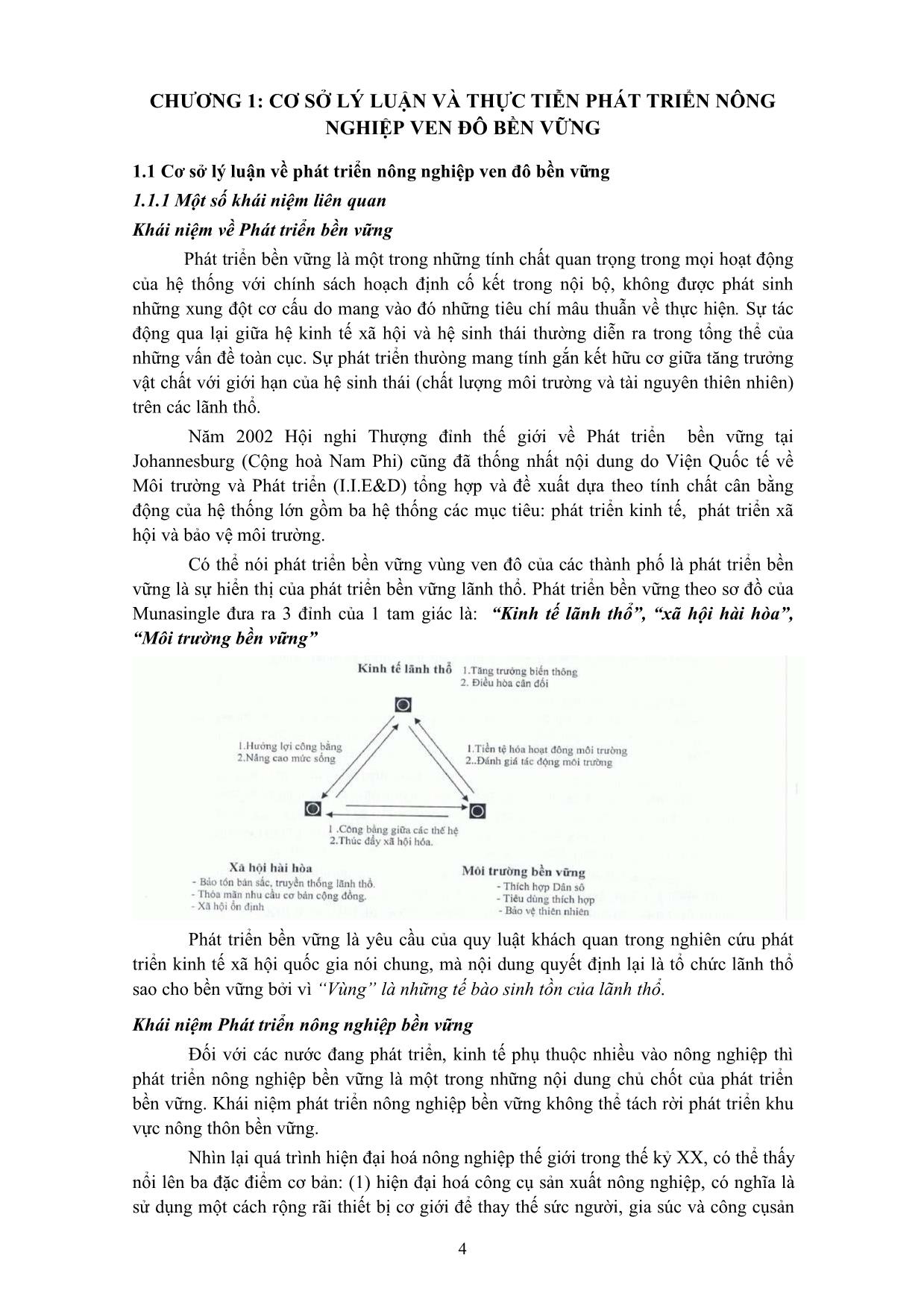
Trang 6
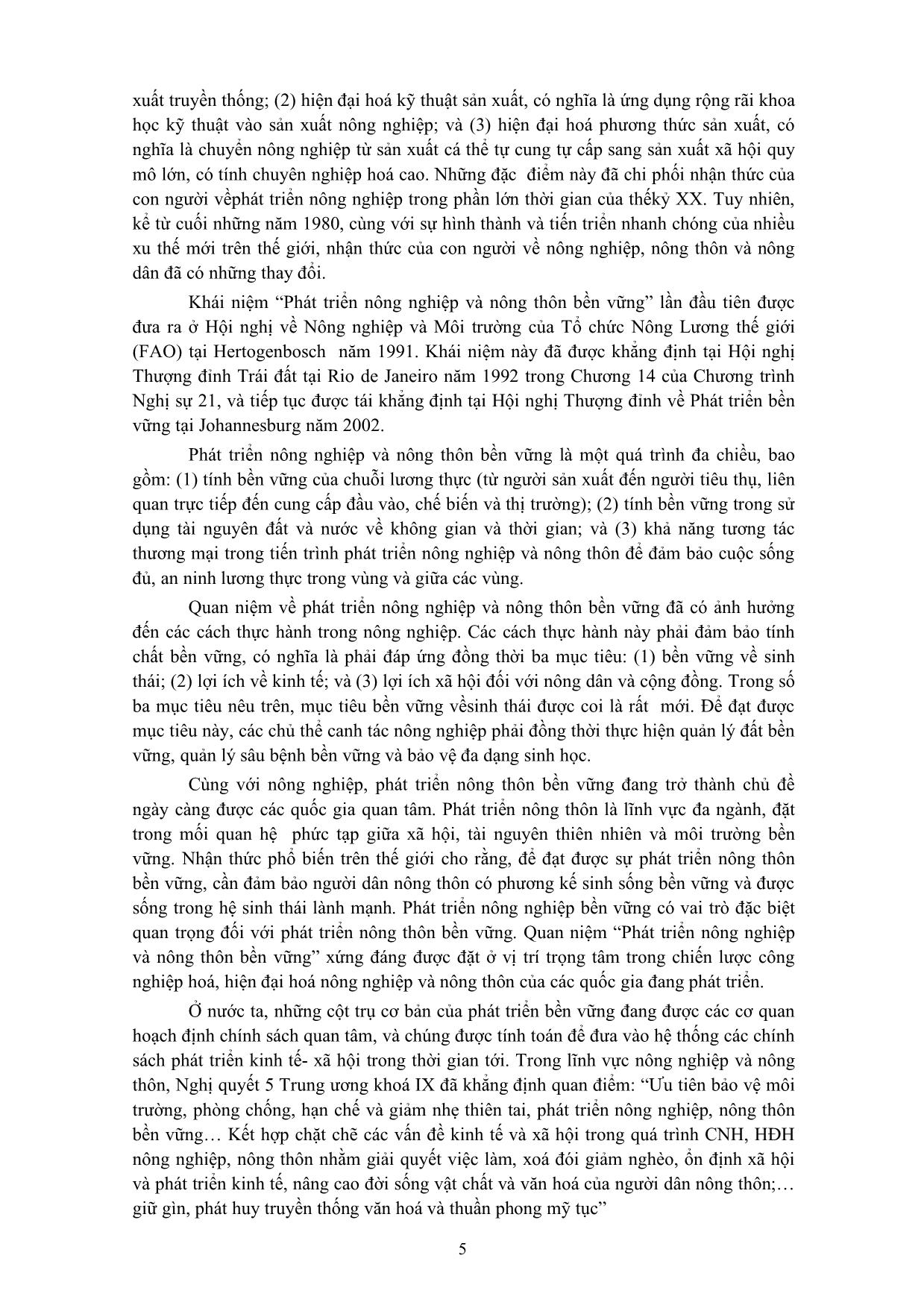
Trang 7
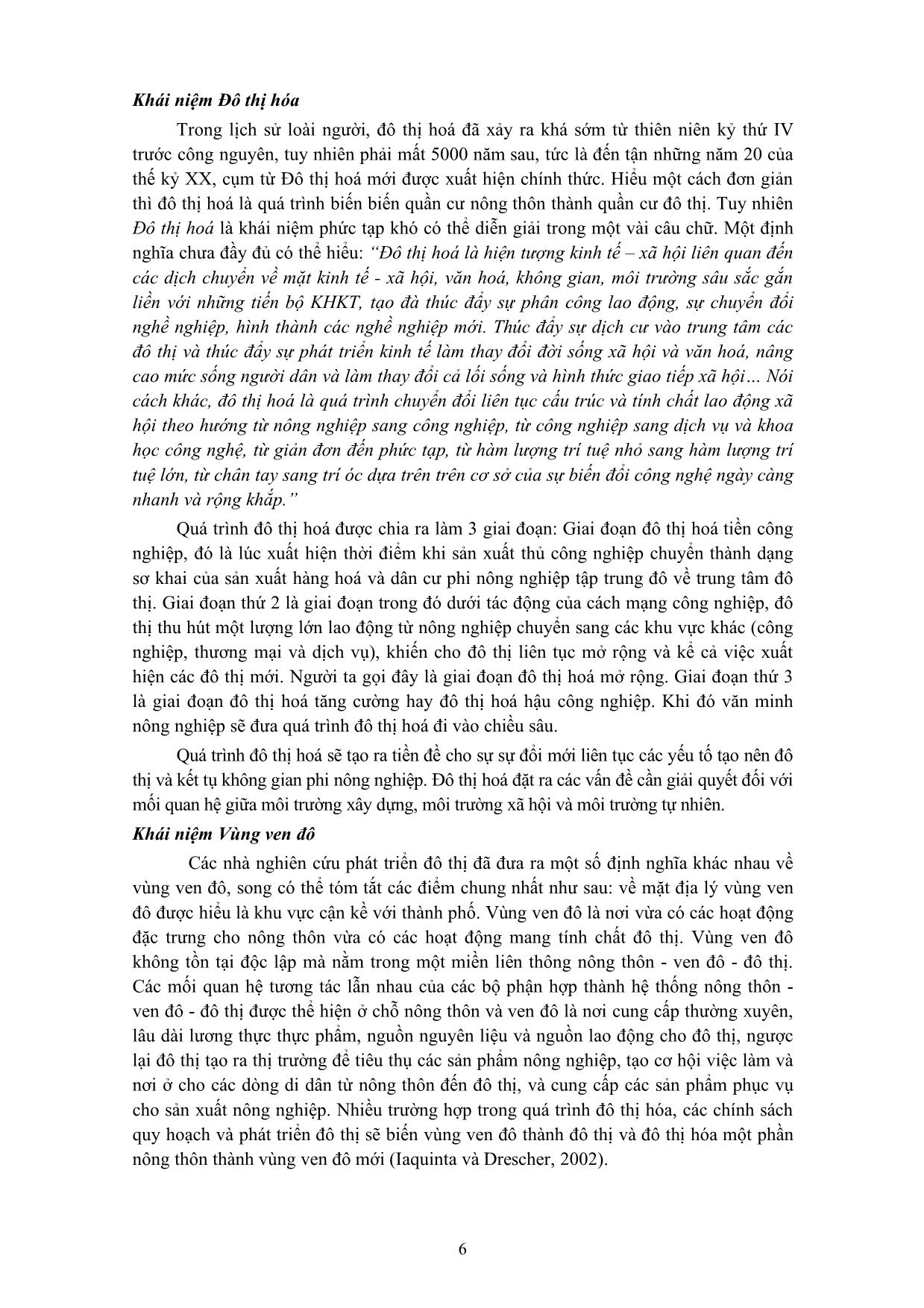
Trang 8
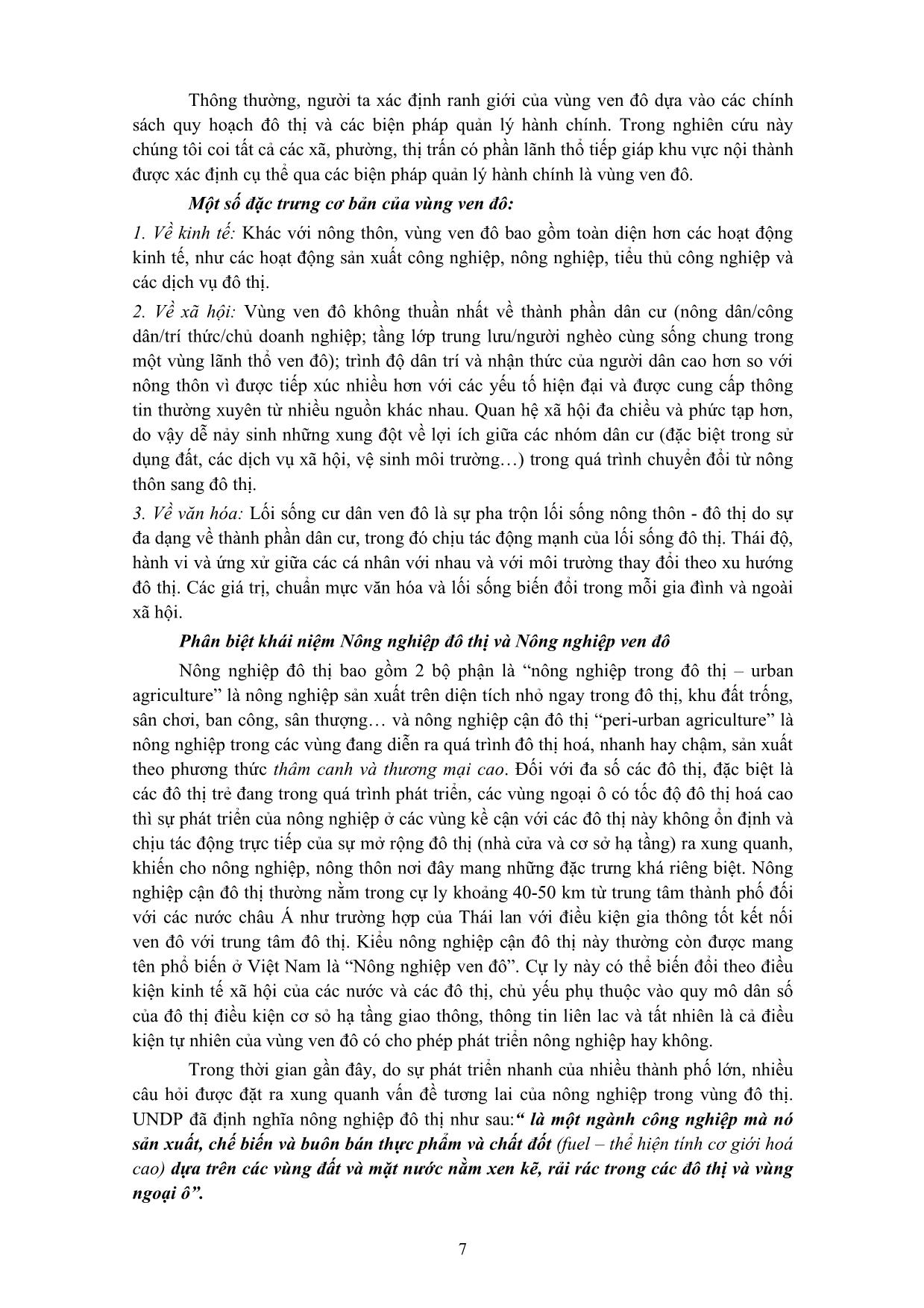
Trang 9
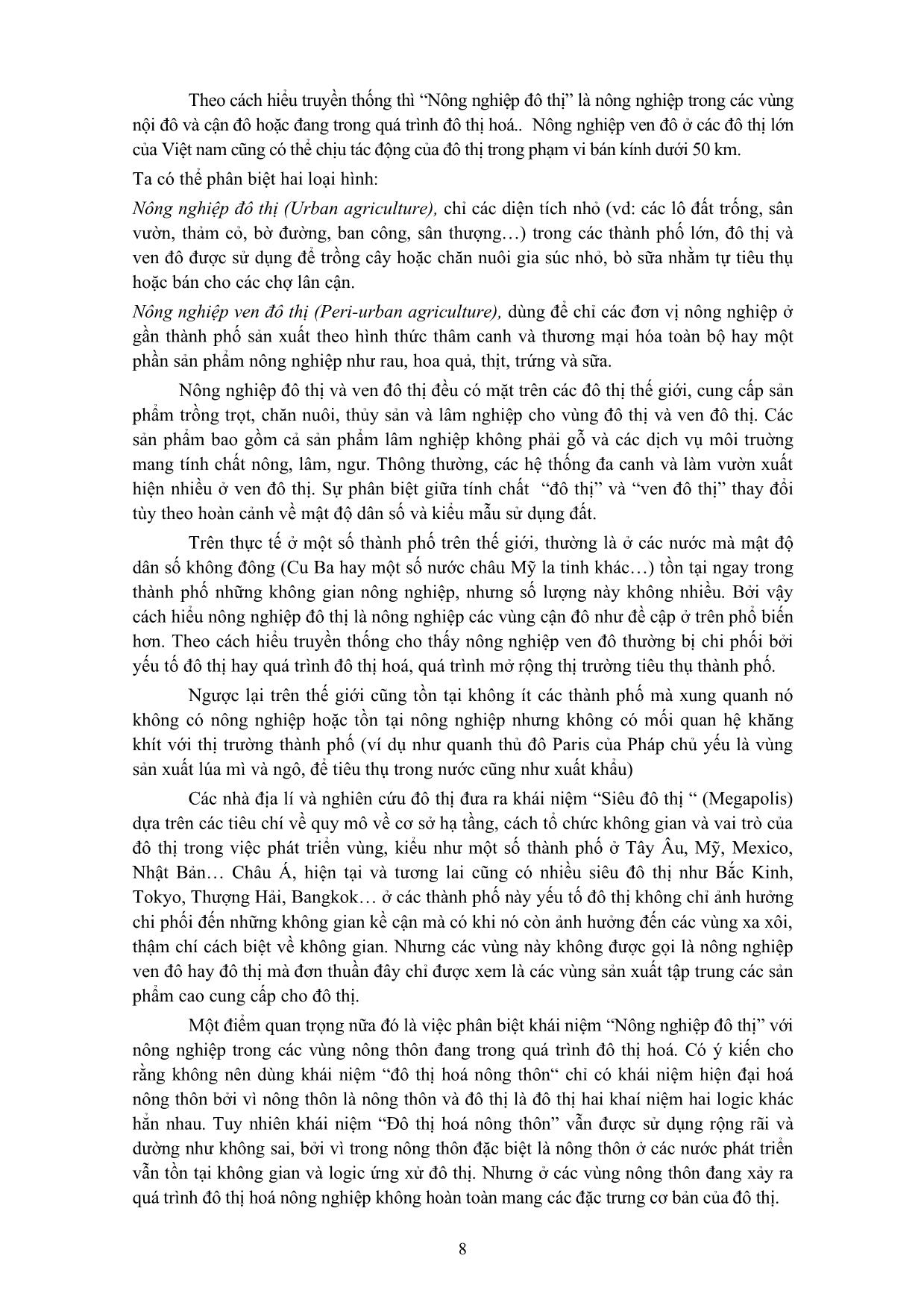
Trang 10
Tải về để xem bản đầy đủ
Tóm tắt nội dung tài liệu: Tài liệu Phát triển nông nghiệp ven đô bền vững ở Việt Nam
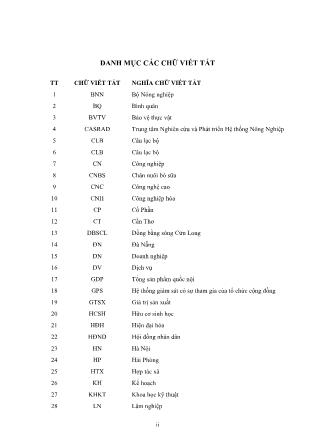
huyển đổi cơ cấu kinh tế nông nghiệp nông thôn mười năm trở lại đây. Đặc biệt, các định hướng nghiên cứu cở bản thúc đẩy quá trình này đã được đề cập hết sức cụ thể. 10. Vũ Trọng Bình, Bùi Thị Thái Đào Thế Anh, 2002: Tổng kết kinh nghiệm nghiên cứu thành công tổ chức nông dân sản xuất tiếp cận thị trường, Viện KHKTNNVN và l’INRA, GRET của Pháp, 50 trang: Cuốn sách đã lột tả quá trình hình thành tổ chức từ nông dân đơn lẻ thành các nhóm, hợp tác xã nhằm giảm giá thành sản phẩm và tiếp cận thị trường. Đây là phương pháp giúp nông dân chuyển dịch cơ cấu sản xuất theo hướng ngày càng chuyên nghiệp hoá, nâng cao khả năng tham gia vào thị trường, tổ chức ngành hàng. 192 11. Quy hoạch phát triển ngành nông nghiệp đến năm 2020 và định hướng đến năm 2025 (2030) của thành phố Hà Nội, TP. Hồ Chí Minh, TP. Hải Phòng, TP. Đà Nắng, TP. Cần Thơ. 12. UBND TP Hà Nội, Sở Nông nghiệp và phát triển nông thôn (2012), Báo cáo quy hoạch phát triển chăn nuôi thành phố Hà Nội đến năm 2020, định hướng đến năm 2030. 13. Niên giám thống kê các thành phố Hà Nội, TP Hồ Chí Minh, Hải Phòng, Đà Nẵng, Cần thơ năm 2011 14. Bộ kế hoạch và đầu tư (2012), Đánh giá tổng quan về thực trạng nông thôn, nông nghiệp từ kết quả Tổng điều tra nông thôn, nông nghiệp và thủy sản năm 2011. 15. Sở Nông nghiệp và phát triển nông thôn, Báo cáo tình hình sản xuất nông nghiệp của thành phố Hà Nội, TP. Hồ Chí Minh, Hải Phòng, Đà Nẵng, Cần Thơ từ năm 2008 – 2011. Tài liệu nước ngoài 1. De Bon H. et Tran Khac Thi. 2000. The response of peri-urban agriculture to urbanization in Vietnam. 7 p. FAVRI, 2000. 2. Le Thanh Hung. 1999. The present status of aquaculture in peri-urban of Ho Chi Minh city, Vietnam. 8p. FAVRI, 1999. 3. Bryant C.R. 1997. L’agriculture peri-urbain: l’economie politique d’un espace innovateur. Cahier Agriculture N6. 125-130. 4. Chia E. et autre. 2001. Le devenir des exploitations agricoles peri-urbain dans la commune de Lampa (Santiago du Chili). V10 N2. 5. Gale F. H. 1999. Agriculture in China’s urban areas: Statistics from China’s agricultureal census. 18p. 6. Deloso M. P. A case study on urban agriculture development in the city of Muntinlupa, Philippines. 7p. 7. Srijantr T. 1999. Condition du developpement de l’agriculture thailandaise. extraction de la these. INAPG. 8. Bridier E. 2000. Etude de la perception de la qualite des legumes par les consommateurs de Hanoi – Cas particulier de la qualite sanitaire. 9. Pham Kim Anh. 1997. Changement des modes alimentaires au Vietnam, en milieu urbain sur une periode de dix ans (entre 1988et1997). DESS Universite de Montpellier 2 10. Johnston B. F. Kilby P., Agriculture and structural transformation, Economic strategies in Late-developing countries, Oxford University Press, New York, 1975. 11. FAO, 1996. Urban and Peri-urban agriculture. 12. Dao The Anh, Fontenelle J.-P., Defourny P., Dao The Tuan - 2001, Atlas of the Bac Hung Hai Polder (Vietnam), Agricultural Publishing House, Hanoi, 58 p. 13. Projet "Dynamiques agricoles en zones d’influence urbaine en Asie du Sud- Est (Vietnam, Cambodge): compétition sur les ressources et création de nouveaux marchés autour des villes secondaires" (RURB-ASIE). INCO (EU). Coopération entre CASRAD-GRET. 2002-2006. 14. Le Quoc Doanh, Le Duc Thinh. Recherche la base scientifique et les eco-technique solution pour le developpement de l’agriculture peri-urbain de Hanoi. MARD 2001- 2003 financement. INSA. 2004 15. Dao The Tuan. 2006. L’agriculture ecologique de Hanoi. 16. Moustier P., Nguyen Thi Tan Loc, Ho Thanh Son, Hoang Bang An. 2007. Promotion of Public-Private Dialogue to Maintain Poor-friendly Fruit and Vegetable Street Vending in Hanoi. ISHS seminar on supply chain management, Hanoi, September 23-27, 2007. Forthcoming in Acta Horticulturae. 193 17. Moustier, P. 2007. Urban Horticulture in Africa and Asia, An Efficient Corner Food Supplier. Forthcoming in Acta Horticulturae. 18. Hubert de Bon, Laurent Parrot et Paule Moustier, 2007. Sustainable Urban Agriculture in developing countries: a review. Soumis à la revue Agronomy. 19. Moustier P., Figuié M., Dao The Anh and Nguyen Thi Tan Loc. Are supermarkets poor- friendly? Debates and evidence from Vietnam. Forthcoming in A. Lindgreen and M. Hingley (eds), “Controversies in Food and Agricultural Marketing,” Gower Publishing. 20. Moustier, P. 2007. Susper final report (Sustainable peri-urban agriculture in South- East Asia). Hanoi, The gioi publishers, 144 p. 21. Anh, M.T.P, M. Ali, H.L. Anh, and T.T.T. Ha. 2004 - Urban And Peri-urban Agriculture in Hanoi: Opportunities and Constraints for Safe and Sustainable Food Production. Shanhua, Taiwan: AVRDC – The World Vegetable Center. Technical Bulletin No. 32 (14) 22. Auriac, F., Vu Chi Dong, 1997 - Villes et organisations de l'espace du Vietnam. Université d'Avignon et des pays du Vaucluse : Laboratoire Structures et Dynamiques Spatiales. Montpellier : RECLUS, Maison de la Gộographie, 34 p. (Publication rộalisộe avec l'appui du service culturel et de coopộration de l'Ambassade de France). 23. Bernasconi, D., 1999 - L'influence de la péri-urbanisation dans la transformation des modes de gestion de l'eau et des déchets. Etude de deux villages de la province de Hanoi. Bordeaux : Université Michel de Montaigne Bordeaux 3, U.F.R. de Géographie, 102 p. (Travail d'étude et de recherche de maitrise). 24. Bui, Tam Tung and Dang, Duong Binh, 1990 - Solving Environmental Problems Along with Development of Hanoi City up to the Year 2000. In International Conference on Environment and Sustainable Development December 3–6, 1990. Ed. by UNDP and State Committee for Sciences, 267–276. Hanoi, Vietnam: UNDP. 25. Bui Thi Gia, W. Bokelmann, and J. P. Ogier, 2000 - Key study on vegetable production in the district of Gia Lam, Hanoi, Vietnam. Proceedings of the XIVth International Symposium on Horticultural Economics, St Peter Port, Guernsey, UK, 12–15 September 2000. Acta-Horticulturae 536: 355–362. (15) 26. CASRAD-GRET, 2006 - Projet "Dynamiques agricoles en zones d’influence urbaine en Asie du Sud-Est (Vietnam, Cambodge) : compétition sur les ressources et crộation de nouveaux marchés autour des villes secondaires" (RURB-ASIE). INCO (EU). Coopération entre CASRAD-GRET. 2002-2006. 27. Chaminade, F., 1999 - Dong Xuan, Quan La, les enjeux de la périurbanisation d'une zone de contact à Hanoi. Bordeaux : Université Michel de Montaigne Bordeaux 3, U.F.R. de Géographie, 150 p. (Travail d'étude et de recherche de maitrise). 28. Crippen Consultants Vancouver, B.C.,1993 - Urban Waste Management Study Hanoi, Haiphong and Ho Chi Minh City. Final Report. CIDA Project E4936K043860. 29. DAO The Anh, 2003. Les réformes socio-économiques et l’adaptation par le choix d’activité des ménages ruraux dans le delta du Fleuve Rouge. These de doctorat. DEA d’ Economie agricole, du développement rural et agro-alimentaire à ENSA Montpellier. 400 p. 30. Dao The Anh, Moustier P., Figuié M.,.2006. Supermarket and the poor. M4P project. 31. Fanchette, S., 2002 - Le delta du Fleuve Rouge (Vietnam) : étude des densités de population et de l’urbanisation des campagnes. Espaces, Populations et Sociétés, p.189-202. 32. Foissy, E. Dynamique d'une zone périurbaine, Thiet Ung - Dong Anh (Hanoi, Vietnam). Bordeaux : Universitộ Michel de Montaigne Bordeaux 3, U.F.R. de Gộographie, 1997, 211 p. (Travail d'étude et de recherche de maợtrise). 194 33. Forbes, D., Thrift, N. (eds). The price of war : urbanization in Vietnam. 1954-1984. London : Allen & Unwin, 1986, 188 p. 34. Gironde, C. Réhabilitation et transformation de l'économie familiale au Nord Vietnam. Systémes d'activités villageois et réseaux de relations dans le delta du Fleuve Rouge. Genève: Institut Universitaire d'Etude du développement, 2001, 395 p. (Thèse de doctorat). 35. Goldblum, C., 1994 - Les politiques incitatives dans le domaine de l'habitat en Asie du sud Est : les possibilités de transfert et d'adaptation de l'ingénierie d'expérimentation du PCA. Bangkok, Singapour, Hanoi, Ho Chi Minh ville, état et perspectives de l'habitat en relation avec le développement urbain. Paris : ARDU, 128 p. 36. Gubry, P. (dir.). Population et développement au Vietnam. Paris : Karthala, CEPED, 2000, 613 p. 37. Ho Thi Lam Tra. 2001. Status of Heavy Metal Pollution of Agricultural Soils and River-Sediments in Central Hanoi. In Waste Reuse in Agriculture in Vietnam: Water Management and Human Health Aspects. Proceedings from a Workshop in Hanoi, Vietnam, March 14, 2001. Edited by Liqa Raschid-Sally, Wim van der Hoek, Mala Ranawaka. IWMI Working Paper 30. (22) 38. Hoang Bang An, Le Nhu Thinh, Dang Dinh Dam, Ngo Van Nam, Le Thuy Hang, Trinh Quang Thoai, Isabelle Vagneron, Paul Moustier. 2003. Spatial and Institutional Organization of Vegetable Market in Hanoi. Sustainable Development of Peri-urban Agriculture in Southeast Asia (SUSPER). Hanoi, Vietnam. (27b) 39. Hoang Xuan Thanh, Dang Nguyen Anh, Cecilia Tacloi. 2005. Livelihood Diversification and Rural-Urban Linkages in Vietnam’s Red River Delta. Food Consumption and Nutrition Division Discussion paper 193. International Food and Policy Research Institute: Washington D.C. (20) 40. Le Thi Nham et al., 1997 - Influence de l'urbanisation sur le éveloppement de l'agriculture suburbaine (Thanh Tri, Hanoi). Etudes Vietnamiennes, n° 123, p. 35-94. 41. Le Quoc Doanh, Le Duc Thinh, Dao The Anh et al. 2004. La base scientifique et les solution technico-socioeconomiques pour le developpement de l’agriculture periurbain de la ville de Hanoi. Rapport du MARD. 193 p. (en Vietnamienne). 42. Li Tana, 1996 - Peasants on the Move - Rural - Urban Migration in the Hanoi region. Singapore : Institute of South-East Asian Studies, 80 p. 43. McGee, T.G., 1995 - The urban future of Vietnam, TWPR, 17 (3), p. 253-277. 44. Moustier P., Vagneron I, Bui Thi Thai. 2004. Some insights on the organization and efficiency of domestic vegetable markets in Hanoi (Vietnam). (3) Cahiers d'études et de recherches francophones / Agricultures. Number 13, volume 1, 142–7, Janvier- Février 2004 - L’alimentation des villes, étude originale. (23c) 45. Moustier P., Vagneron I. and Bui Thi Thai, 2004. Organisation et efficience des marchés de légumes approvisionnant Hanoi (Vietnam). In: Cahiers Agricultures, Jan- Feb pp. 142-147. 46. Moustier P., and Danso G., 2006. Local economic development and marketing of urban produced food. In: Cities farming for the future: urban agriculture for green and productive cities, R. van Veenhuizen. Ruaf Foundation, Idrc, Iirr, 7, pp. 173- 208.(www.ruaf.org) 47. Moustier, P., Figuiộ, M., N.T.T. Loc and H.T. Son, 2006. The role of coordination in the safe and organic vegetable chains supplying Hanoi. In Acta Horticulturae, n°699, pp. 297-303. 48. Moustier, P. 2007. Susper final report (Sustainable peri-urban agriculture in South- East Asia). Hanoi, The gioi publishers, 144 p. 49. Nguyen Hanh Nguyen, Cu Thanh Phuc. 2002. Measures to minimize the impact of plant protection of chemical residues in agro-products in vegetable production in suburban and adjacents of Hanoi. Science and Technology Journal of Agriculture 195 and Rural Development, (in Vietnamese). Ministry of Agriculture and Rural Development, Vietnam. No.3: 205–207. (10) 50. Pham, Van Khoi. 2004. Removal of urgent issues for rapid development of private economy in Hanoi suburb agriculture. Science and Technology Journal of Agriculture and Rural Development, (in Vietnamese). Ministry of Agriculture and Rural Development, Vietnam. 2004, no.1: 11–13. (10) 51. Phi, Van Ky and Nguyen Dinh Long. 2003. Some basic solutions for market development in Hanoi suburbs and rural areas. Science and Technology Journal of Agriculture and Rural Development, (in Vietnamese). No.11: 1355–1356. (10) 52. Satoshi Takizawa. 2002. Wastewater Reuse for Agriculture and Aquaculture in Hanoi, Vietnam. From E-conference: Agricultural use of untreated wastewater in low income countries, 24 June–5 July 2002. (29b) 53. Nguyen Trac. L’eau, la ville et l’urbanisme. Hanoi. Nanterre : Acadộmie de l’eau, 1996, 32 p. 54. Pandolphi, L. Une terre sans prix. Paris : Universitộ de Paris 8, Institut Francais d'Urbanisme, 2001, 567 p. (These de doctorat). 55. Quertamp, F., De Bon, H., Baudoin, N. (Eds). Le développement périurbain à Hanoi, nouveaux enjeux. Hanoi : Les cahiers de la coopération française au Vietnam, no 5, 2002, 138 p. 56. Quertamp, F. - 2007 -La périurbanisation de Hanoi : grille d’analyse de la double transition vietnamienne. In Numéro spécial des Annales de Géographie SCHAR, P. (Dir) Mutations économiques et recompositions territoriales en Asie du Sud et du Sud-Est. 57. Quertamp F., 2003 - Hanoi, une périurbanisation paradoxale. Transition et Métropolisation, Analyse cartographique. Thèse de doctorat en Géographie, sous la direction de M. Georges ROSSI, Talence : Université Michel de Montaigne Bordeaux 3 (2 tomes), 2003, 604 p. 58. Douglass M., DiGregorio M. and al, (2002) : Urban transition in Vietnam, Department of Urban and Regional Planning, University of Hawaii at Manoa, Honolulu, Hawaii, USA & United Nations Centre for Human Settlements 59. Nguyen Xuan Hoan, 2004 - L’émergence des cluster dans les zones rurales périurbaines : l’exemple de la province de Bac Ninh au Vietnam, mémoire de DEA d’Economie, Université de St Quentin les Yvelines, ss. dir. Pr. D. Requier- Desjardins, 121 p. 60. Kunio Tsubota, Urban agriculture inAsia: Lessons from Japanesse Experience 61. Woong Kwon, Challenges and Various Developmental Strategies in the Korean Urban/Peri-Urban Agriculture 62. Supot Kasem - Department of Plant Pathology Faculty of Agriculture, Kasetsart University, Overview of Urban and Peri-Urban Agriculture status in Thailand 63. James Petts (2008), Urban agriculture in London 196 PHỤ LỤC Bản đồ thực trạng sản xuất nông nghiệp các thành phố Hình 1: Bản đồ đất sản xuất nông nghiệp so với diện tích tự nhiên Hà Nội năm 2011 197 Hình 2: Bản đồ cơ cấu diện tích rau đậu - diện tích đất SXNN Hà Nội năm 2011 198 Hình 3: Bản đồ phân bố làng nghề thành phố Hà Nội 199 Hình 4: Bản đồ diện tích lúa TP. Hồ Chí Minh năm 2011 200 Hình 5: Bản đồ diện tích rau đậu TP. Hồ Chí Minh năm 2011 201 Hình 6: Bản đồ tỷ lệ diện tích cây hàng năm trên đất sản xuất nông nghiệp Hải Phòng năm 2011 Hình 7: Bản đồ tỷ lệ diện tích rau đậu trên đất sản xuất nông nghiệp Hải Phòng 2011 202 Hình 8: Bản đồ cây hàng năm trên đất sản xuất nông nghiệp Đà Nẵng năm 2011 Hình 9: Bản đồ diện tích sản xuất lúa Đà Nẵng năm 2011 203 Hình 10: Bản đồ diện tích lúa Cần Thơ năm 2011 Hình 11: Bản đồ diện tích rau đậu Cần Thơ năm 2011 204
File đính kèm:
 tai_lieu_phat_trien_nong_nghiep_ven_do_ben_vung_o_viet_nam.pdf
tai_lieu_phat_trien_nong_nghiep_ven_do_ben_vung_o_viet_nam.pdf

